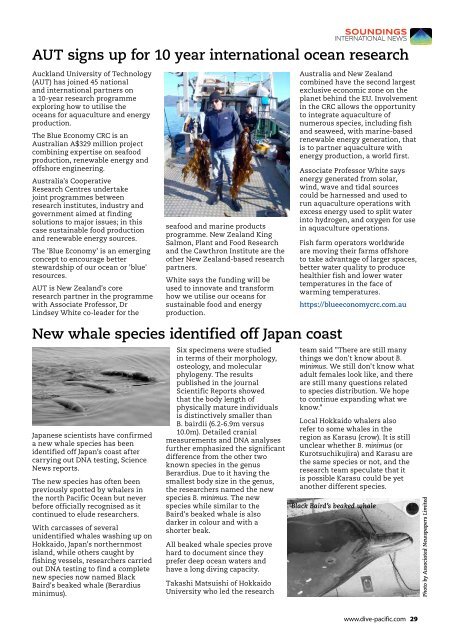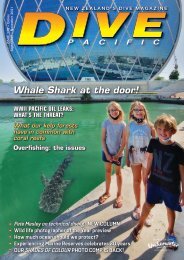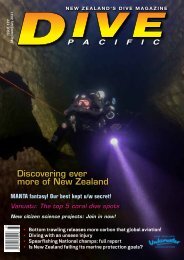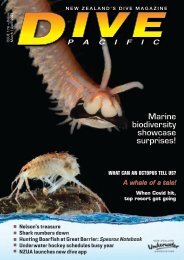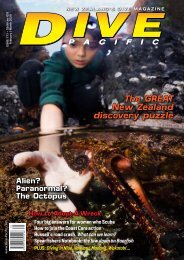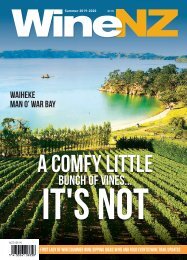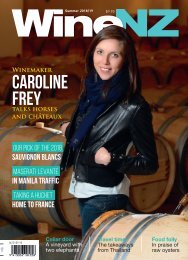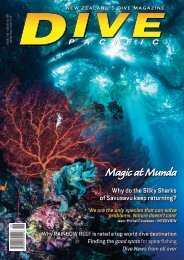Dive Pacific Iss 171 Oct- Nov 2019
New Zealand's dive magazine featuring in this issue: Shooting big sharks, up close; Spearfishing at night!; Remembering a great Kiwi dive pioneer, Wade Doak; Forgotten Vanuatu wreck's claim to fame; The invasive Lionfish - in depth, plus all our expert columnists
New Zealand's dive magazine featuring in this issue: Shooting big sharks, up close; Spearfishing at night!; Remembering a great Kiwi dive pioneer, Wade Doak; Forgotten Vanuatu wreck's claim to fame; The invasive Lionfish - in depth, plus all our expert columnists
Create successful ePaper yourself
Turn your PDF publications into a flip-book with our unique Google optimized e-Paper software.
SOUNDINGS<br />
INTERNATIONAL NEWS<br />
AUT signs up for 10 year international ocean research<br />
Auckland University of Technology<br />
(AUT) has joined 45 national<br />
and international partners on<br />
a 10-year research programme<br />
exploring how to utilise the<br />
oceans for aquaculture and energy<br />
production.<br />
The Blue Economy CRC is an<br />
Australian A$329 million project<br />
combining expertise on seafood<br />
production, renewable energy and<br />
offshore engineering.<br />
Australia's Cooperative<br />
Research Centres undertake<br />
joint programmes between<br />
research institutes, industry and<br />
government aimed at finding<br />
solutions to major issues; in this<br />
case sustainable food production<br />
and renewable energy sources.<br />
The 'Blue Economy' is an emerging<br />
concept to encourage better<br />
stewardship of our ocean or 'blue'<br />
resources.<br />
AUT is New Zealand's core<br />
research partner in the programme<br />
with Associate Professor, Dr<br />
Lindsey White co-leader for the<br />
seafood and marine products<br />
programme. New Zealand King<br />
Salmon, Plant and Food Research<br />
and the Cawthron Institute are the<br />
other New Zealand-based research<br />
partners.<br />
White says the funding will be<br />
used to innovate and transform<br />
how we utilise our oceans for<br />
sustainable food and energy<br />
production.<br />
Australia and New Zealand<br />
combined have the second largest<br />
exclusive economic zone on the<br />
planet behind the EU. Involvement<br />
in the CRC allows the opportunity<br />
to integrate aquaculture of<br />
numerous species, including fish<br />
and seaweed, with marine-based<br />
renewable energy generation, that<br />
is to partner aquaculture with<br />
energy production, a world first.<br />
Associate Professor White says<br />
energy generated from solar,<br />
wind, wave and tidal sources<br />
could be harnessed and used to<br />
run aquaculture operations with<br />
excess energy used to split water<br />
into hydrogen, and oxygen for use<br />
in aquaculture operations.<br />
Fish farm operators worldwide<br />
are moving their farms offshore<br />
to take advantage of larger spaces,<br />
better water quality to produce<br />
healthier fish and lower water<br />
temperatures in the face of<br />
warming temperatures.<br />
https://blueeconomycrc.com.au<br />
New whale species identified off Japan coast<br />
Japanese scientists have confirmed<br />
a new whale species has been<br />
identified off Japan’s coast after<br />
carrying out DNA testing, Science<br />
News reports.<br />
The new species has often been<br />
previously spotted by whalers in<br />
the north <strong>Pacific</strong> Ocean but never<br />
before officially recognised as it<br />
continued to elude researchers.<br />
With carcasses of several<br />
unidentified whales washing up on<br />
Hokkaido, Japan's northernmost<br />
island, while others caught by<br />
fishing vessels, researchers carried<br />
out DNA testing to find a complete<br />
new species now named Black<br />
Baird's beaked whale (Berardius<br />
minimus).<br />
Six specimens were studied<br />
in terms of their morphology,<br />
osteology, and molecular<br />
phylogeny. The results<br />
published in the journal<br />
Scientific Reports showed<br />
that the body length of<br />
physically mature individuals<br />
is distinctively smaller than<br />
B. bairdii (6.2-6.9m versus<br />
10.0m). Detailed cranial<br />
measurements and DNA analyses<br />
further emphasized the significant<br />
difference from the other two<br />
known species in the genus<br />
Berardius. Due to it having the<br />
smallest body size in the genus,<br />
the researchers named the new<br />
species B. minimus. The new<br />
species while similar to the<br />
Baird's beaked whale is also<br />
darker in colour and with a<br />
shorter beak.<br />
All beaked whale species prove<br />
hard to document since they<br />
prefer deep ocean waters and<br />
have a long diving capacity.<br />
Takashi Matsuishi of Hokkaido<br />
University who led the research<br />
team said "There are still many<br />
things we don't know about B.<br />
minimus. We still don't know what<br />
adult females look like, and there<br />
are still many questions related<br />
to species distribution. We hope<br />
to continue expanding what we<br />
know."<br />
Local Hokkaido whalers also<br />
refer to some whales in the<br />
region as Karasu (crow). It is still<br />
unclear whether B. minimus (or<br />
Kurotsuchikujira) and Karasu are<br />
the same species or not, and the<br />
research team speculate that it<br />
is possible Karasu could be yet<br />
another different species.<br />
Black Baird’s beaked whale<br />
Photo by Associated Newspapers Limited<br />
www.dive-pacific.com 29


